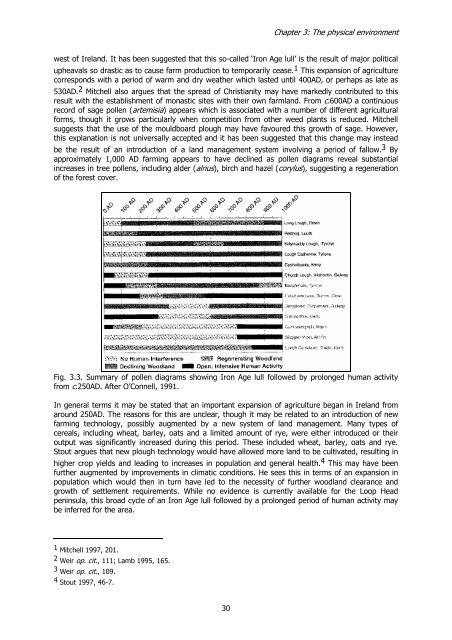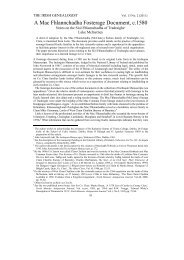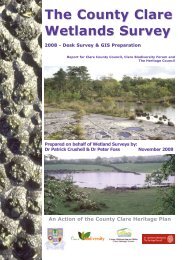A Statistical Analysis of Ringfort Distribution and Morphology on the ...
A Statistical Analysis of Ringfort Distribution and Morphology on the ...
A Statistical Analysis of Ringfort Distribution and Morphology on the ...
You also want an ePaper? Increase the reach of your titles
YUMPU automatically turns print PDFs into web optimized ePapers that Google loves.
Chapter 3: The physical envir<strong>on</strong>ment<br />
west <str<strong>on</strong>g>of</str<strong>on</strong>g> Irel<str<strong>on</strong>g>and</str<strong>on</strong>g>. It has been suggested that this so-called ‘Ir<strong>on</strong> Age lull’ is <strong>the</strong> result <str<strong>on</strong>g>of</str<strong>on</strong>g> major political<br />
upheavals so drastic as to cause farm producti<strong>on</strong> to temporarily cease. 1 This expansi<strong>on</strong> <str<strong>on</strong>g>of</str<strong>on</strong>g> agriculture<br />
corresp<strong>on</strong>ds with a period <str<strong>on</strong>g>of</str<strong>on</strong>g> warm <str<strong>on</strong>g>and</str<strong>on</strong>g> dry wea<strong>the</strong>r which lasted until 400AD, or perhaps as late as<br />
530AD. 2 Mitchell also argues that <strong>the</strong> spread <str<strong>on</strong>g>of</str<strong>on</strong>g> Christianity may have markedly c<strong>on</strong>tributed to this<br />
result with <strong>the</strong> establishment <str<strong>on</strong>g>of</str<strong>on</strong>g> m<strong>on</strong>astic sites with <strong>the</strong>ir own farml<str<strong>on</strong>g>and</str<strong>on</strong>g>. From c.600AD a c<strong>on</strong>tinuous<br />
record <str<strong>on</strong>g>of</str<strong>on</strong>g> sage pollen (artemisia) appears which is associated with a number <str<strong>on</strong>g>of</str<strong>on</strong>g> different agricultural<br />
forms, though it grows particularly when competiti<strong>on</strong> from o<strong>the</strong>r weed plants is reduced. Mitchell<br />
suggests that <strong>the</strong> use <str<strong>on</strong>g>of</str<strong>on</strong>g> <strong>the</strong> mouldboard plough may have favoured this growth <str<strong>on</strong>g>of</str<strong>on</strong>g> sage. However,<br />
this explanati<strong>on</strong> is not universally accepted <str<strong>on</strong>g>and</str<strong>on</strong>g> it has been suggested that this change may instead<br />
be <strong>the</strong> result <str<strong>on</strong>g>of</str<strong>on</strong>g> an introducti<strong>on</strong> <str<strong>on</strong>g>of</str<strong>on</strong>g> a l<str<strong>on</strong>g>and</str<strong>on</strong>g> management system involving a period <str<strong>on</strong>g>of</str<strong>on</strong>g> fallow. 3 By<br />
approximately 1,000 AD farming appears to have declined as pollen diagrams reveal substantial<br />
increases in tree pollens, including alder (alnus), birch <str<strong>on</strong>g>and</str<strong>on</strong>g> hazel (corylus), suggesting a regenerati<strong>on</strong><br />
<str<strong>on</strong>g>of</str<strong>on</strong>g> <strong>the</strong> forest cover.<br />
Fig. 3.3. Summary <str<strong>on</strong>g>of</str<strong>on</strong>g> pollen diagrams showing Ir<strong>on</strong> Age lull followed by prol<strong>on</strong>ged human activity<br />
from c.250AD. After O’C<strong>on</strong>nell, 1991.<br />
In general terms it may be stated that an important expansi<strong>on</strong> <str<strong>on</strong>g>of</str<strong>on</strong>g> agriculture began in Irel<str<strong>on</strong>g>and</str<strong>on</strong>g> from<br />
around 250AD. The reas<strong>on</strong>s for this are unclear, though it may be related to an introducti<strong>on</strong> <str<strong>on</strong>g>of</str<strong>on</strong>g> new<br />
farming technology, possibly augmented by a new system <str<strong>on</strong>g>of</str<strong>on</strong>g> l<str<strong>on</strong>g>and</str<strong>on</strong>g> management. Many types <str<strong>on</strong>g>of</str<strong>on</strong>g><br />
cereals, including wheat, barley, oats <str<strong>on</strong>g>and</str<strong>on</strong>g> a limited amount <str<strong>on</strong>g>of</str<strong>on</strong>g> rye, were ei<strong>the</strong>r introduced or <strong>the</strong>ir<br />
output was significantly increased during this period. These included wheat, barley, oats <str<strong>on</strong>g>and</str<strong>on</strong>g> rye.<br />
Stout argues that new plough technology would have allowed more l<str<strong>on</strong>g>and</str<strong>on</strong>g> to be cultivated, resulting in<br />
higher crop yields <str<strong>on</strong>g>and</str<strong>on</strong>g> leading to increases in populati<strong>on</strong> <str<strong>on</strong>g>and</str<strong>on</strong>g> general health. 4 This may have been<br />
fur<strong>the</strong>r augmented by improvements in climatic c<strong>on</strong>diti<strong>on</strong>s. He sees this in terms <str<strong>on</strong>g>of</str<strong>on</strong>g> an expansi<strong>on</strong> in<br />
populati<strong>on</strong> which would <strong>the</strong>n in turn have led to <strong>the</strong> necessity <str<strong>on</strong>g>of</str<strong>on</strong>g> fur<strong>the</strong>r woodl<str<strong>on</strong>g>and</str<strong>on</strong>g> clearance <str<strong>on</strong>g>and</str<strong>on</strong>g><br />
growth <str<strong>on</strong>g>of</str<strong>on</strong>g> settlement requirements. While no evidence is currently available for <strong>the</strong> Loop Head<br />
peninsula, this broad cycle <str<strong>on</strong>g>of</str<strong>on</strong>g> an Ir<strong>on</strong> Age lull followed by a prol<strong>on</strong>ged period <str<strong>on</strong>g>of</str<strong>on</strong>g> human activity may<br />
be inferred for <strong>the</strong> area.<br />
1 Mitchell 1997, 201.<br />
2 Weir op. cit., 111; Lamb 1995, 165.<br />
3 Weir op. cit., 109.<br />
4 Stout 1997, 46-7.<br />
30
















